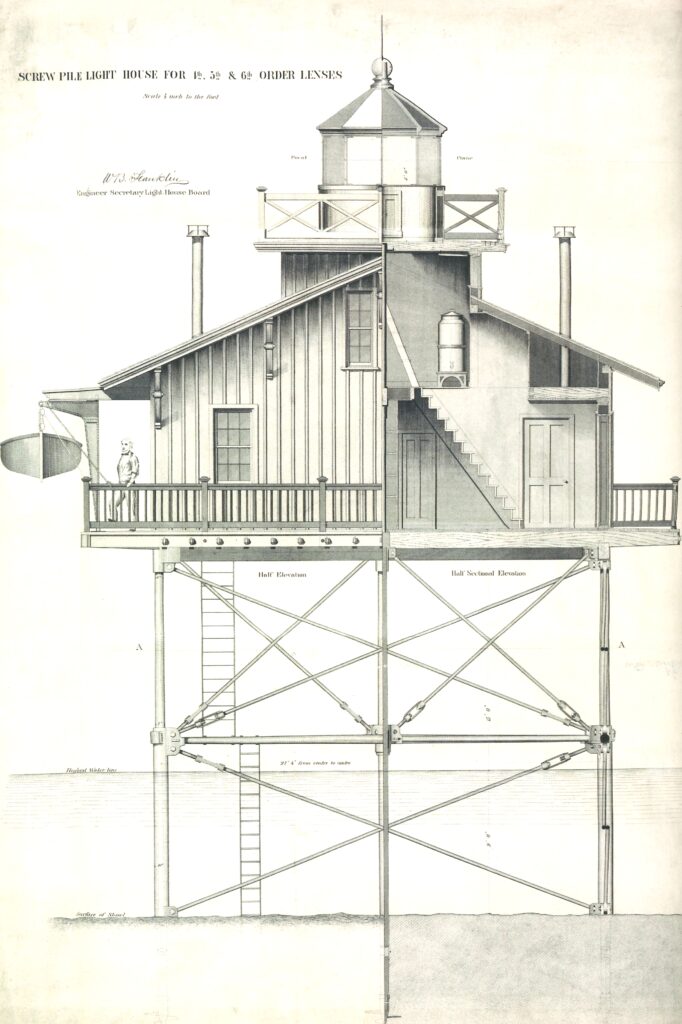For the average person, the word “lighthouse” conjures up images of a tall masonry tower on dry land. However, one of the most widely used lighthouse designs in American history is the opposite of that stereotype in almost every way. What the modest little screwpile cottage lighthouse lacks in stature it made up for in its widespread use, with more than a hundred such structures built in the 19th century between Long Island Sound and Texas (plus a few in California).

A typical square cottage-style lighthouse.
(National Archives)
Alexander Mitchell invented the screwpile in England, receiving a patent in 1833. The end of his iron pilings had a spiral blade which would be twisted into the ground. The design was intended for use in maritime environments, particularly were the bottom was soft mud or sand. These pilings proved very effective in the right conditions and were adopted for use in the United States. The first such tower was built on Delaware Bay’s Brandywine Shoal in 1850. Some large offshore iron skeletal lighthouses use these pilings, although others instead use straightpiles with footers because the ocean floor is unsuited for screwpiles (the Florida Reef Lights are the most prominent example). Whether screwpile or straightpile, iron skeletal towers are almost entirely metal and general range from about 50 to 150 feet tall.
During the rapid expansion of the Lighthouse Service in the 1850s, there were many in-water locations that needed a lighted aid to navigation but for which a large lighthouse was unnecessary. The result was the screwpile cottage lighthouse. Typically a 1.5-story wooden house with a lantern centered on top sat on four or more vertical iron screwpiles. The broad, shallow waters of Chesapeake Bay had 42 such lighthouses, with at least two dozen more in North Carolina’s Albemarle and Pamlico Sounds. These simple and relatively inexpensive lighthouses were usually prefabricated at the Baltimore Lighthouse Depot. Screwpile cottages were normally “stag stations” – two keepers living there without their families. As local aids to navigation these lighthouses had a 4th-order Fresnel lens or smaller.
The first screwpile cottage light in the U.S. was probably Pungoteague Creek Lighthouse on the Chesapeake Eastern Shore. The hexagonal structure on seven screwpiles lasted only 459 days before being destroyed by an ice flow. Pungoteague was probably designed by Hartman Bache. Details are sketchy, but most of the early screwpile cottages were likely either the work of Bache and/or Lighthouse Board Engineer Secretary Edmund Hardcastle.

(National Archives)
In 1859, William B. Franklin (Lighthouse Board Engineer Secretary) created a standardized design for a square cottage lighthouse on screwpiles. This design would be tweaked after the Civil War by later engineers like Jared A. Smith and William A. Jones, but was never radically changed. At least 45 lighthouses were built using this design, the last probably being the third Horn Island Lighthouse, Mississippi (1906).
One of the more recognizable variations added dormer windows to all four sides of the lighthouse for easier living in warmer climates. At least five lighthouses of this type were built on the Gulf Coast, plus Roe Island in California. Another rare variant with a larger two-story dwelling was used on at least four lighthouses, including two in California.
In my next column I’ll look at some of the other screwpile cottage designs.

Square screwpile cottage variant with dormers.
(USCG Historian’s Office via USLHS Digital Archives)

Josh Liller is the Historian and Collections Manager for Jupiter Inlet Lighthouse & Museum. He also serves as a Historian for the Florida Lighthouse Association. He is co-author of the revised edition of Five Thousand Years On The Loxahatchee: A Pictorial History of Jupiter-Tequesta, Florida (2019) and editor of the second edition of The Florida Lighthouse Trail (2020).


Nice article for Part 1! Are there any archival or measured drawing blueprints available on these on the Chesapeake Bay lighthouses? Have a friend that wanted to try to rebuild or replicate the structure?
Thanks!
T.
Hi Tom – I will email you about this.